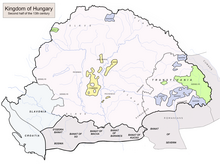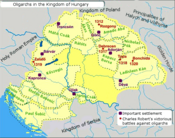Theodore Vejtehi
Theodore Vejtehi | |
|---|---|
Ban of Severin (debated) | |
| Reign | c. 1291–1316 |
| Predecessor | Lawrence (?) |
| Successor | John Vejtehi (?) |
| Died | 1327 |
| Noble family | gens Csanád |
| Issue | John Nicholas a daughter |
| Father | Dominic |
Theodore Vejtehi (Hungarian: Vejtehi Tivadar, Romanian: Teodor Voitici; died 1327), also Theodore Csanád, was an influential lord in the Kingdom of Hungary at the turn of the 13th and 14th centuries, who ruled the Banate of Severin (Hungarian: Szörénység) de facto independently of the central royal power.[1]
Family
Theodore (II) was born into the gens Csanád as the son of Dominic, who was mentioned by a record in 1256. He had a brother Ernye. The kindred, according to the tradition, originated from chieftain Csanád, a relative of Stephen I of Hungary and founder and first ispán of Csanád County which named after him. Theodore's direct ancestor was Bogyoszló. Theodore appeared in the contemporary sources first in 1285 in a false diploma, when he, alongside Ernye, participated in the county assembly at Csanád. He had three children: John, Nicholas and an unidentified daughter, who married royal notary Gál Omori.[2]
In 1256, the Vejtehi branch of the genus owned possessions and vineyards in Csanád, Temes, Syrmia Counties and in the Duchy of Macsó and Požega County beyond the river Sava. Furthermore, they also had lands in Győr, Moson and Vas Counties at the other end of the kingdom.
Lord of Severin

Theodore preceded
When Charles I signed an alliance with his cousin
The Vejtehi family, Theodore and his sons, governed their province from Miháld Castle (today in ruins near Mehadia) which presumably was built by themselves. There are no other known castles owned by Theodore,
Decline
According to a royal charter from 1317, Charles' loyal general Paul Szécsi led a campaign in autumn 1316 to besiege Miháld which defended by John Vejtehi, son of Theodore. By that time Theodore was already in custody and taken tied up before the castle and dragged along the walls at the heels of a horse to persuade John to surrender the fort. In spite of all these, Szécsi was unable to take Miháld, however defeated the army of despot Michael Shishman in the nearby battlefield.[13] Szécsi sent several Hungarian and Bulgarian prisoners of war to the royal court of Charles.[6] According to Pál Engel, who dated the first siege to 1314, Charles I personally led a next royal campaign against the Vejtehis following his victories in Transylvania at the end of 1321 or early 1322. The castle was besieged and successfully occupied by the King and general Martin, son of Bogár, a former familiaris of oligarch Matthew Csák. John Vejtehi was pardoned and allowed to settle down his estate in Temes County, while Denis Szécsi, Paul's brother was installed castellan. In the following months Szécsi expanded his influence along the Lower Danube by taking Görény Castle from the Bulgarians.[14]
Because of the elusive chronology of the events,
Theodore survived his downfall. In 1322 Theodore (now mentioned as magister) and his two sons donated the estates of Szentlászló and Szentmargit (today parts of
References
- ^ a b Kristó 1979, p. 144.
- ^ Engel: Genealógia (Genus Csanád 1., Bogyoszló branch)
- ^ Zsoldos 2011, p. 50.
- ^ Engel 1996, p. 32.
- ^ Engel 1996, p. 46.
- ^ a b c d Györffy 1964, p. 539.
- ^ Kristó 1999, p. 42.
- ^ Kristó 1999, p. 53.
- ^ Kristó 1979, p. 159.
- ^ Kristó 1979, p. 189.
- ^ a b Györffy 1964, p. 540.
- ^ Kristó 1979, p. 206.
- ^ Engel 1988, pp. 104–105.
- ^ Engel 1988, p. 130.
- ^ Kristó 2003, p. 328.
- ^ Kristó 2003, p. 343.
- ^ Vásáry 2005, pp. 124–125.
Sources
- Engel, Pál (1988). "Az ország újraegyesítése. I. Károly küzdelmei az oligarchák ellen (1310–1323) [Reunification of the Realm. The Struggles of Charles I Against the Oligarchs (1310–1323)]". Századok (in Hungarian). 122 (1–2). Magyar Történelmi Társulat: 89–146. ISSN 0039-8098.
- Engel, Pál (1996). Magyarország világi archontológiája, 1301–1457, I [Secular Archontology of Hungary, 1301–1457, Volume I] (in Hungarian). História, MTA Történettudományi Intézete. ISBN 963-8312-44-0.
- Györffy, György (1964). "Adatok a románok XIII. századi történetéhez és a román állam kezdeteihez [Contributions to the 13th-century History of the Romanians and the Origin of the Romanian State]". Történelmi Szemle (in Hungarian). 7 (3–4). ISSN 0040-9634.
- Kristó, Gyula (1979). A feudális széttagolódás Magyarországon [Feudal Anarchy in Hungary] (in Hungarian). Akadémiai Kiadó. ISBN 963-05-1595-4.
- Kristó, Gyula (1999). "I. Károly király főúri elitje (1301–1309) [The Aristocratic Elite of King Charles I, 1301–1309]". Századok (in Hungarian). 133 (1). Magyar Történelmi Társulat: 41–62. ISSN 0039-8098.
- Kristó, Gyula (2003). "I. Károly király harcai a tartományurak ellen (1310–1323) [The Struggles of Charles I Against the Oligarchs (1310–1323)]". Századok (in Hungarian). 137 (2). Magyar Történelmi Társulat: 297–347. ISSN 0039-8098.
- Vásáry, István (2005). "The Tatars fade away from Bulgaria and Byzantium, 1320–1354". Cumans and Tatars: Oriental military in the pre-Ottoman Balkans, 1185–1365. Cambridge University Press. ISBN 978-0-521-83756-9.
- Zsoldos, Attila (2011). Magyarország világi archontológiája, 1000–1301 [Secular Archontology of Hungary, 1000–1301] (in Hungarian). História, MTA Történettudományi Intézete. ISBN 978-963-9627-38-3.

